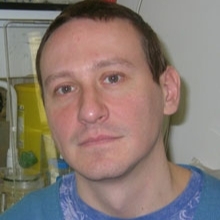Professor Nikolay Zenkin awarded 2014 Fleming Prize
16 April 2014

Professor Nikolay Zenkin was awarded the 2014 Fleming Prize at the Society for General Microbiology Annual Conference. Nikolay, Professor of Molecular Biology at Newcastle University, researches RNA polymerase and its work in gene expression. His prize lecture, Multiple personalities of RNA polymerase active centre, was held at 12.10 in Hall 1A.
As we understand it, you were born in a town known for physics research?
That’s right, Dubna the nuclear physics research centre of the former USSR and now Russia. My father was doing a PhD there – he was a quantum physicist. We moved to Moscow when I was five.
You ended up going down the biology route – were you ever tempted to become a physicist?
I did consider it – I knew physics and maths quite well – but reading biology articles in New Scientist was the tipping point that made me want to be a biologist. I studied at Moscow State University for five years, then studied for my PhD at the Institute of Molecular Genetics at the Russian Academy of Sciences.
What was your PhD on?
I worked on RNA polymerase then too. During my last year of university – the equivalent of a Master’s degree – I worked on RNA polymerases from different bacteria and their sensitivities to rifampicin. I continued on in the same lab to do my PhD.
You spent part of your PhD studying in the Waksman Institute of Rutgers University in New Jersey. Did you experience a culture shock moving as a young researcher?
Not really, I knew English quite well from school, but Konstantin Severinov’s lab, where I was working, was almost entirely Russian, so I had no problems adapting. I did have to return home to defend my PhD thesis – in Russia you have to do this within three years of starting to avoid being conscripted into the army. Once you’ve passed, you can’t be called up.
You returned to America and ultimately moved to Newcastle. How have you found it in the North East?
Honestly? I find Newcastle to be similar to Russia – obviously the language and architecture are different, but I feel at home here. My girlfriend and I have been here for seven years now and I’ve never felt that I needed to move. When I was in the US, I felt I had to move on after about three years.
You now have your own group working on RNA polymerase. Can you tell us a little about it?
RNA polymerase is an ancient cellular machine that reads DNA, providing information that ribosomes can translate into proteins. You can think of DNA as a DVD movie; all the information about the film is on the disc, but you need a computer – ribosomes and RNA polymerase – to read the information and turn it into pictures on a screen. Ribosomes and RNA polymerase are found in all living organisms, without exception. We work on bacteria as model organisms for RNA polymerase, because they are easier to work with, but the mechanisms are similar across the board.
What are you working on at the moment?
We look at everything to do with RNA polymerase, from how RNA synthesis occurs through to how RNA polymerase interacts with other cellular machines. It’s a vast field. There are so many fundamental questions to be answered about RNA polymerase and its role in gene expression.
During your research, what’s surprised you about RNA polymerase?
In a way, every topic that we’ve published on has surprised me. There can be very exciting moments – you want to find the answers to these exciting questions. Every publication I have is on something that was very exciting to me at the time.
Many people suspect that the earliest life on Earth is RNA based. Is this something you’ve researched?
The ‘RNA world’ existed before RNA polymerase, which, being an enzyme, is made out of proteins. I had a paper on the hypothesis of how translation – reading RNA and producing proteins – evolved. Of course, with this subject you can only hypothesise, but primordial evolution is something I’m hugely interested in. RNA polymerase existed before the Bacteria and Archaea diverged (at the very beginning of life as we know it), in what was known as the ‘RNA-protein world’.
Will we ever understand what the ‘last common ancestor’ (LCA) from which Bacteria and Archaea diverged was?
There’ll be lots of hypothesising, but I think we can work back to the LCA. We have a good idea of how many genes are required to support life, for instance. Evidence suggests that the LCA was probably RNA-protein based, rather than DNA based. DNA appears to have been introduced to cells by viruses and bacteriophages.
What will you be talking about today in your prize lecture?
Today I’ll be discussing an accumulation of several papers and discoveries that build into a nice story. It’s about the discovery of a part of the active centre of RNA polymerase that hadn’t been recognised for many years. I’ll be talking about how this catalytic domain manages the fidelity and regulation of transcription.
So even though this enzyme had been researched for decades there was still an unknown part?
I think the breakthrough for researchers working on RNA polymerase was the first crystal structure of the enzyme, which appeared in 1999. Before that, people spent decades doing some groundbreaking research, but knowing the crystal structure people were able to delete specific regions of RNA polymerase, to see what they did. In my first project in the US I deleted a part with an unknown function; three years later it was identified as a new catalytic domain.
What does winning this award mean to you?
I looked at the list of previous winners and saw that a couple of them were Nobel laureates – I’m very proud. It’s my first big prize so I’m delighted with the recognition.
